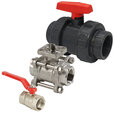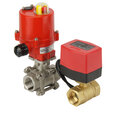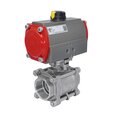Plug valve vs ball valve
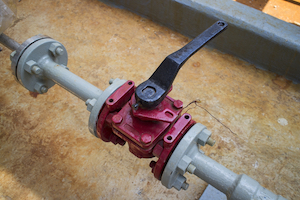
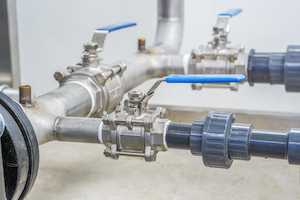
Figure 1: Plug valve (left) and ball valve (right)
Plug valves and ball valves are used across various industries to control the flow of liquids and gasses. Both have unique features and design differences that make them suitable for different applications. To help determine which type of valve is more suitable for a given application, this article explores the key differences between plug and ball valves, including their design, function, advantages, and disadvantages.
View our online selection of ball valves!
What is a plug valve
A plug valve (Figure 1 left) is a quarter-turn valve that uses a tapered or cylindrical plug to control the flow of liquids or gasses. The plug rotates within the valve body to open or close the flow path. Plug valves are known for their simple design and ability to provide tight shutoff, making them a popular choice in various industries, including water treatment, oil and gas production, chemical processing, and pulp and paper manufacturing.
What is a ball valve
A ball valve (Figure 1 right) is a quarter-turn valve that uses a ball with a bore to control the flow of liquids or gasses. The ball rotates on its axis to open or close the flow path. Ball valves have fast and efficient operation, durability, and a long lifespan. They are used in heating and cooling systems, water distribution, and industrial process cooling.
Plug valve vs ball valve differences
Plug and ball valves differ in the following aspects:
1. Operation principle
Plug valve operation
The plug valve consists of a body with either a tapered or parallel seat. A plug fits into this seat. The plug is designed with an opening whose position determines the amount of opening through the valve. These openings in the valve body, known as ports, allow fluid to enter or exit. When the plug is turned 90 degrees, it fully opens or closes the fluid flow. However, despite being a quarter-turn valve, the plug valve is less efficient when compared to ball valves, and they can only function in the fully open or closed position. When the port in the plug is aligned with the inlet and outlet ports, fluid flow continues through the valve. However, a pressure drop occurs through the reduced area of the plug port, which is a disadvantage compared to a ball valve.
Ball valve operation
A ball valve is a quarter-turn valve that uses a hollow, perforated, and pivoting ball to control flow. The ball rotates within the valve body to control fluid flow, and its simple design makes it easy to operate and maintain. A valve stem connects to the ball. When the valve stem is turned a quarter-turn, the bore is either open to the flow allowing media to flow through, or closed to prevent media flow.
2. Sealing properties
Both plug and ball valves are quarter-turn valves that close and open when their stem is rotated by 90 degrees. These valves are primarily used for shut-off purposes. However, there are a few differences between them.
Plug valve sealing
The surface area for sealing in a plug valve is noticeably more significant than that of a ball valve. This results in improved sealing capabilities, necessitating greater operation effort and torque.
Ball valve sealing
Ball valves are lighter in weight and easier to operate due to their low torque requirements. The smaller sealing area in these valves may lead to a sealing performance below that of plug valves; however, recent innovations in seal injections and chemical sealing solutions have effectively addressed this issue.
3. Types
Plug valve types
Plug valves are classified based on whether they are lubricated and the shape of their plugs.
- Lubricated plug valves are designed to operate with a lubricant film between the plug and the valve body. This lubrication helps to reduce friction and wear on the plug and body, increasing the valve's operational life and reliability. Lubricated plug valves also offer tighter sealing and improved performance in high-pressure applications.
Non-lubricated plug valves, on the other hand, do not require a lubricant and are typically used in applications where the fluid being controlled is incompatible with the lubricant. Non-lubricated plug valves are also preferred in applications where a lubricant may pose a contamination risk, such as in the food and beverage industry.
- The openings within the plug can have different shapes (like rounded or rectangular).
Ball valve types
Ball valves are categorized based on several parameters.
- 2-way, 3-way, etc depending on the circuit function.
- Full port, standard port, reduced port, or v-port based on their bore size and shape.
- Floating or trunnion, based on whether the ball floats inside the valve body or is supported on a pivot.
- 1,2,3-piece ball valves based on the number of body components.
4. Maintenance
Both plug and ball valves require routine maintenance to ensure optimal performance.
Plug valve maintenance
Plug valves are more manageable due to their straightforward design and limited moving components. The plug can be easily removed and cleaned, while accessing the rest of the valve body for cleaning purposes is also simple.
Ball valve maintenance
Ball valves present a greater challenge when cleaning. The ball or disc is situated deep inside the valve, making it challenging to access. Over time, the cavity of the ball valve may accumulate debris from the medium, further complicating the cleaning and maintenance process.
5. Cost
Plug valves offer a more cost-effective operation compared to ball valves. The plug in the plug valve fits snugly under the bushing, which helps to prevent wear and tear on the valve body and plug. Simply replacing the bushing and top seal is sufficient to maintain the valve's function and ensure longevity.
6. Application
Plug valve application
Plug valves are suitable for applications involving abrasive materials, such as sewage, mud, and slurries, due to their increased surface area and unrestricted fluid flow. They ensure a tight seal when handling corrosive substances, and their anti-corrosive properties make them a reliable option for challenging applications.
Ball valve application
A ball valve is a popular choice for automation, particularly in industries such as natural gas and crude oil transfer, LNG plants, polymer production, and field gas processing. They are also useful in various industrial environments, including turbine and compressor skids, oil refinery feedstock lines, tank farms, and hydrocarbon processing. Read our ball valve applications article for more details.
7. Longevity
Plug valve longevity
A large surface of the plug valve contacts the medium, increasing the chances of corrosion. Handling more torque also exposes the plug valve to more wear.
Ball valve longevity
Ball valves have features that prevent the medium from coming into contact with the disc. The lower torque also reduces wear and tear in the long run. Read our article on ball valves for corrosive media to know more about how to design a ball valve for corrosive environments.
Conclusion
Plug and ball valves regulate fluid flow using a straightforward on or off function or a multipath feature. Take the following into consideration when choosing when to use a ball valve vs a plug valve:
- A plug valve is the best choice for sensitive applications as they offer perfect sealing and a straightforward application structure. Also, they cost less than ball valves. However, they are not as compact as ball valves and cause a pressure drop from inlet to outlet.
- Choose ball valves for large high-pressure applications that require an easier operation. They are easier to use and are more compact than plug valves but with slightly reduced sealing capabilities.
For example, a ball valve would be the better choice for an application that requires regulating fluid flow in a water treatment plant because it allows flow direction changes and can handle high-pressure and temperature applications. A plug valve would be more suitable to regulate fluid flow in a pipeline system involving slurry as it requires less maintenance and allows for a straight fluid flow. However, ball valves are more commonly used for shutoff applications due to their simple and lightweight design and ease of use due to their torque-free operation. Table 1 compares the features of plug valves and ball valves.
Table 1: Plug valve vs ball valve
| Feature | Plug valve | Ball valve |
| Operation principle | Plug with an opening that controls flow through ports. | Hollow, perforated ball that pivots to control flow. |
| Sealing properties | Larger sealing area, better sealing, requires more effort and torque. | Easier operation, lighter, smaller sealing area, potentially less effective sealing than plug valves |
| Types | Categorized by lubrication and plug shape (rounded, rectangular, etc.). | Categorized by bore size/shape and ball support (floating or pivoted). |
| Maintenance | Easy to clean. | Difficult to clean due to deep-seated parts. |
| Cost | Less costly. | More costly. |
| Application | Suitable for abrasive materials like sewage, mud, and slurries. | Ideal for automation in industries like natural gas, oil, LNG, and plumbing. |
| Longevity | Less durable. | More durable. |
FAQs
Why choose plug valves over ball valves?
Plug valves have a better sealing ability than ball valves because they have a larger sealing surface.
Are plug valves better than ball valves?
Typically, plug valves have a shorter lifespan than ball valves. This is because plug valves have a higher potential to undergo erosion as more fluids come into contact with the cylinder. On the other hand, ball valves have less contact with fluids, require less torque, and have more moving components.
What is the difference between an eccentric plug valve vs a ball valve?
An eccentric plug valve has a plug-shaped, flow-restricting component that rotates in an eccentric direction, and a ball valve regulates the flow of liquids or gasses by using a ball with a bore.




